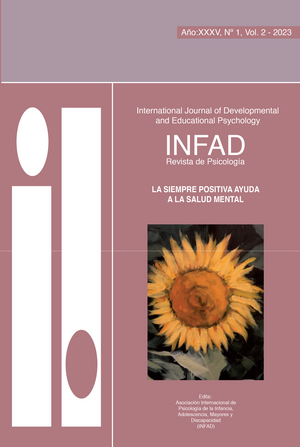Redes sociales virtuales e internet, y su uso por los mayores
Contenido principal del artículo
Resumen
Vivimos en una sociedad en la que la conexión a internet se ha integrado de tal manera que forma parte de los actos más cotidianos. Se supone que las tecnologías contribuyen de manera importante a mejorar nuestra calidad de vida, aunque no siempre parece que sea así. Algunos mayores se resisten a su uso, percibiendo que las tecnologías les hacen la vida “más complicada”. Sin embargo, no hay manera de escapar de su presencia o de la de internet. Sabemos que este proceso es irreversible. Por lo tanto, no les queda otra que adaptarse a esta situación. Por ello, un aspecto relevante para la vida de los silver es conocer y analizar cómo las TIC o las TRIC les afectan ycómo las utilizan,yes por lo que, nos plantearnoscomo objetivo en estetrabajo:conocer algunas características relevantes en relación con el uso internet y de las redes sociales virtuales por parte de los mayores, así como, la influencia que están teniendo en la vida de estas personas. La metodología seguida ha sido, el análisis de una seleccionada revisión bibliográfica sobre este tema que, a su vez, nos ha permitido elaborar una serie reflexiones propias. Los datos presentados han sido extraídos de fuentes como: ONTSI, INE, Comisión Europea, AIMC, Ministerio de Asuntos Económicos y Transformación Digital, etc. De ahí, se pudieron obtener una serie de aportaciones de interés, véase como muestra que, en el año 2020, el 93,2% de la población utilizaba internet en un periodo de tres meses, siendo este porcentaje más alto que la media de la UE, mientras que en los mayores entre 65 y 74 años desciende al 69,7%.
Detalles del artículo
Sección

Esta obra está bajo una licencia internacional Creative Commons Atribución-NoComercial-SinDerivadas 4.0.
Aquellos autores/as que tengan publicaciones con esta revista, aceptan los términos siguientes:
- Los autores/as conservarán sus derechos de autor y garantizarán a la revista el derecho de primera publicación de su obra, el cuál estará simultáneamente sujeto a la Licencia de reconocimiento de Creative Commons que permite a terceros copiar y redistribuir el material en cualquier medio o formato bajo los siguientes términos: —se debe dar crédito de manera adecuada, brindar un enlace a la licencia, e indicar si se han realizado cambios. Puede hacerlo en cualquier forma razonable, pero no de forma tal que sugiera que usted o su uso tienen el apoyo de la licenciante (Atribución); — no se puede hacer uso del material con propósitos comerciales (No Comercial); — si se remezcla, transforma o crea a partir del material, no podrá distribuirse el material modificado (Sin Derivadas).
- Los autores/as podrán adoptar otros acuerdos de licencia no exclusiva de distribución de la versión de la obra publicada (p. ej.: depositarla en un archivo telemático institucional o publicarla en un volumen monográfico) siempre que se indique la publicación inicial en esta revista.
- Se permite y recomienda a los autores/as difundir su obra a través de Internet (p. ej.: en archivos telemáticos institucionales o en su página web) antes y durante el proceso de envío, lo cual puede producir intercambios interesantes y aumentar las citas de la obra publicada. (Véase El efecto del acceso abierto).

Este obra está bajo una licencia de Creative Commons Reconocimiento-NoComercial-SinObraDerivada 4.0 Internacional.
Cómo citar
Referencias
AIMC (2021). Asociación para la Investigación de Medios de Comunicación. https://www.aimc.es/%20otrosestudios-trabajos/navegantes-la-red/
Castells P. & De Bofarull I. (2002). Enganchados a las pantallas. Planeta Prácticos.
Del Barrio Fernández, Á. (2014). Los adolescentes y el uso de los teléfonos móviles y de videojuegos. International Journal of Developmental and Educational Psychology., 3(1), 563–570. https://doi.org/10.17060/ijodaep.2014.n1.v3.536
Del Barrio Fernández, Á, & Ruiz Fernández, I. (2014). Los adolescentes y el uso de las redes sociales. International Journal of Developmental and Educational Psychology., 3(1), 571–576. https://doi.org/10.17060/ijodaep.2014.n1.v3.537
Del Barrio Fernández, A., Gutiérrez Martínez, I., & del Barrio, J. A. (2015a). Los abuelos y su influencia en el uso del tiempo libre y las actividades extraescolares de los nietos adolescentes. International Journal of Developmental and Educational Psychology., 1(2), 207–218. https://doi.org/10.17060/ijodaep.2015.n2.v1.336
Del Barrio A., & Gutiérrez I. (2015b). Las TIC: Una mirada a los hábitos de los adolescentes que viven con sus abuelos. International Journal of Developmental and Educational Psychology., 1(1), 251–264. https://doi.org/10.17060/ijodaep.2015.n1.v1.97
Del Barrio, Á. (2017): Las tecnologías de la información y la comunicación en la vida y la educación de los adolescentes. UEX. https://dehesa.unex.es/handle/10662/6529
Del Barrio, Á. & Ruiz, I. (2017). Hábitos de uso del WhatsApp por parte de los adolescentes. International Journal of Developmental and Educational Psychology., 2(1), 23–30. https://doi.org/10.17060/ijodaep.2015.n1.v1.97
Digital news report (2021). Reuters Institute. https://reutersinstitute.politics.ox.ac.uk/digital-news-report/2021
INE (2021). Población que usa Internet (en los últimos tres meses). https://www.ine.es/uc/ekfL67UW
Juárez, B. (2020). Análisis de la cultura virtual en las redes sociales como organización digital. Prisma Social, nº 30, 295–321
McKinsey & Company (2021). Global digital sentiment survey. https://mck.co/3NU5XvU
Noriega, C. & Velasco, C. (2013) Relaciones de abuelos y nietos: una aproximación al rol del abuelo. Sociedad y Utopia: Revista Ciencias Sociales, Nº 41. 464- 482.
ONTSI (2022a). Informe Tecnología+Sociedad en España 2021. Ministerio de Asuntos Económicos y Transformación Digital.
ONTSI (2022b). Beneficios y riesgos del uso de Internet y las Redes Sociales. Colección Brújula. Ministerio de Asuntos Económicos y Transformación Digital.
Programa Europa Digital 2021-2027. Comisión Europea. https://bit.ly/eu_digital_27
Turkle, S. (2017). En defensa de la conversación. Barcelona. Ático de Los Libros
Vaucheret G.E. (2004). El adolescente y los medios de comunicación. En: Castellano, G., Hidalgo, M.I., Redondo C., & Romero AM. (2004). Medicina de la adolescencia. Atención integral. Madrid: Ergón.
NOTAS
https://www.youtube.com/channel/UCXwkTn4CJ_HlzwflkxASBoQ Pirata y las Pros.

